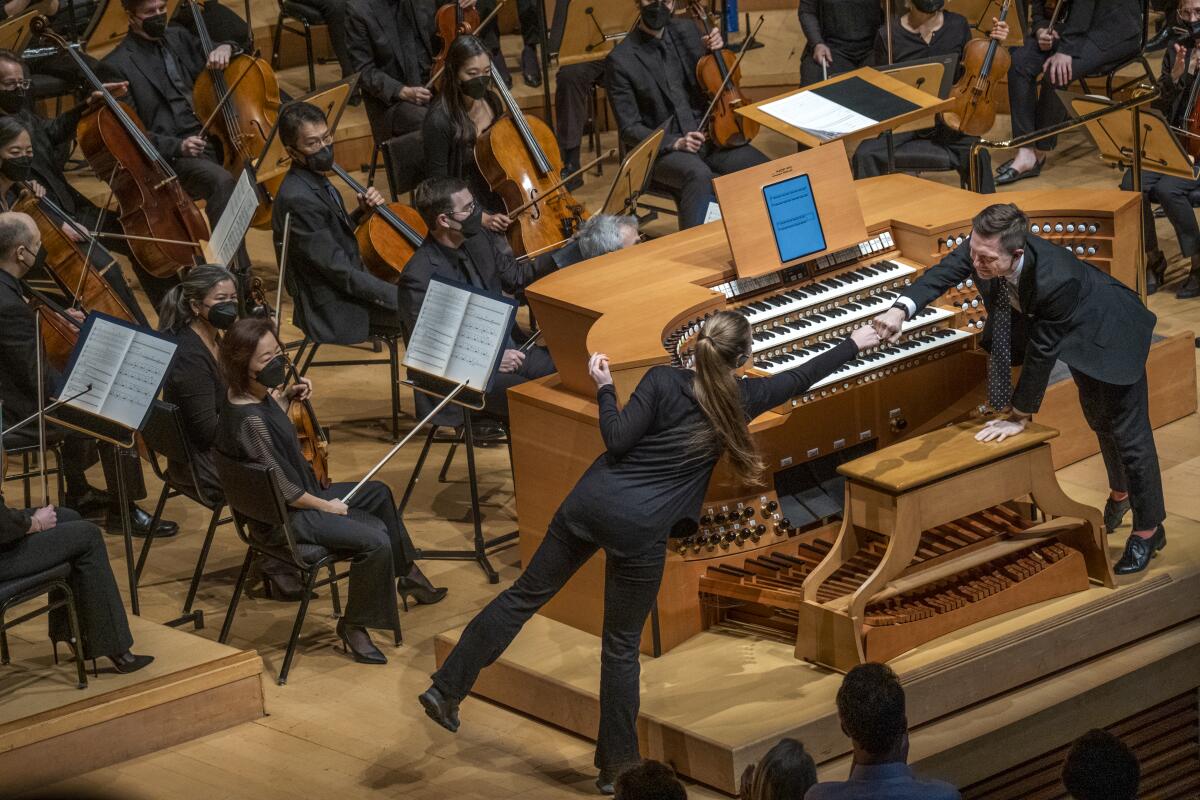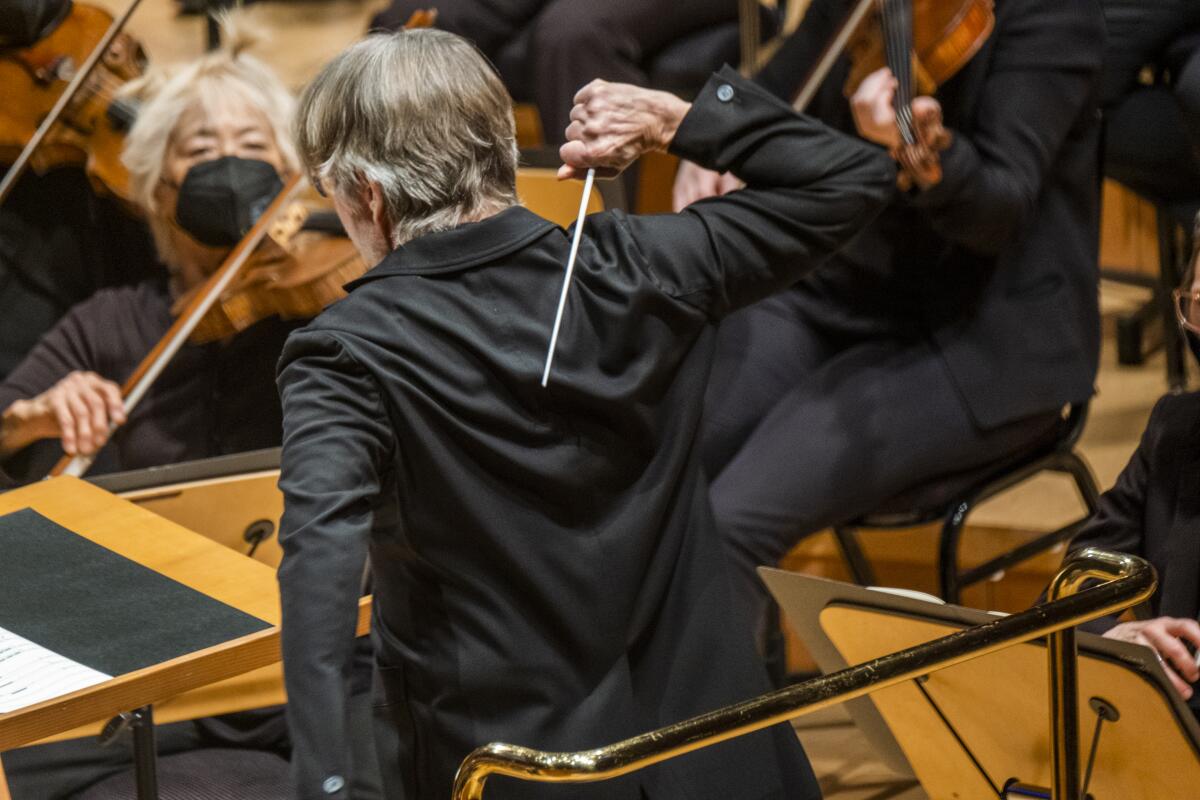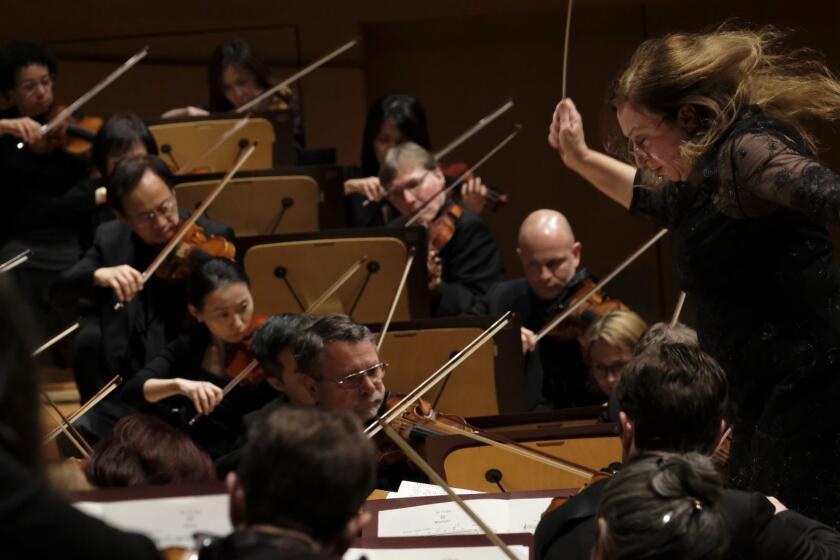Review: Esa-Pekka Salonen makes a triumphant return to the L.A. Phil

As we continue to drive Omicron out of town, Walt Disney Concert Hall is inching back to becoming its beloved old self. Saturday afternoon, it came closer with the return of Esa-Pekka Salonen for the first time in more than two years. Nothing could seem more natural than that.
It was Salonen, after all, who, as music director of the Los Angeles Philharmonic, helped convincingly champion the hall in the 1990s when too much of the town was against it and too little of its money was for it. Salonen triumphantly helped open the hall in 2003 as the world watched in envy. He then brilliantly recognized the hall’s potential to transform the L.A. Phil into the influential, trailblazing institution it has become.
COVID-19 rules and regulations remain in place to remind us that Disney is not yet a maskless or vax-less venue. Performers still fist-bump rather than shake hands. The Saturday matinee was not quite sold out, as it would have been in pre-pandemic times. But attendance is growing to the point that the L.A. Phil is back to filling seats behind the stage.
This felt like almost as much of a homecoming as Gustavo Dudamel’s first concert back in the hall in the fall because Salonen made the program itself a tribute to Disney: to what it is, has meant and can be.
He began by giving us a peek back to when the hall was still under construction, the stage not yet intact and an antsy architect who simply couldn’t wait to hear music in the hall. One sleepless night, Frank Gehry called Salonen and told him he had keys to the joint. He suggested the conductor bring his violin and give concertmaster Martin Chalifour a call — and that the three of them head downtown pronto (the story varies slightly depending upon who tells it and when). Then the violinist, clad in a hard hat, stood in front of where the stage would be. The conductor and architect, similarly donning hard hats, stood on the top balcony and held hands. On hearing the first notes of Chalifour playing the solo Bach partita that night, the goose bumps came, as Gehry has recalled, then the tears. The acoustics worked.
Salonen began Saturday’s program, the first in his two-week residency with the L.A. Phil, by having a young violinist, Gabriela Peña-Kim, play that same opening prelude to Bach’s Partita No. 3 for solo violin from the back of the balcony, presumably where he and Gehry had stood that fateful night. Bach gorgeously wafting from the rafters had the effect of making audible memory out of an acoustic fog. That led directly into “Fog.”
As a 90th birthday present to Frank O. Gehry, Salonen wrote a 10-minute chamber piece, a fantasy based on that Bach prelude, which he titled after the architect’s initials. The “Fog” premiere took place almost exactly three years earlier across the street from Disney, at the Colburn School. During the pandemic lockdown, Salonen fully orchestrated the fantasy and now has brought it “home” to Disney for its U.S. premiere.

Salonen is not the first to have fantasized this Bach prelude. Lukas Foss had a go at it in 1967 — psychedelically banging Bach around until the prelude becomes a hopeless rock ’n’ roll catastrophe — and led it at the Ojai Music Festival in 1994, just when fundraising for Disney had sunk catastrophically. Unlike Foss’ “Phorion,” “Fog” is exuberant, dazzling in its instrumental colors and virtuosic rhythmic machinations, full of the promise an ever-vital architect has to offer. Chalifour was concertmaster rather than soloist here. Bach belonged to all the orchestra, and rather than obsess with the prelude, Salonen, as the Wizard of “Fog,” used it as a launching point for a journey in the Salonenland, where everything sounds new and changeable.
Disney was also, in its way, the centerpiece for the premiere of Gabriella Smith’s “Breathing Forests,” an organ concerto by the 30-year-old composer from Berkeley. Smith happened to have a work performed by the L.A. Phil three years ago in a concert with Philip Glass’ Symphony No. 12, which featured organist James McVinnie. McVinnie asked her for an organ concerto, and the L.A. Phil commissioned it.
That concerto became “Breathing Forests,” which Smith wrote in her program note is meant to represent a “sonic forest, growing, breathing, burning and regenerating.” She meant it to express her sadness for the consequential loss, incumbent joy of ecosystems and outrage at inflaming climate change.
Yet rather than conform to the typical pastoral-sounding wind, rain, thunder, birds, beasts and babbling brooks, Smith’s three movements — “Grow,” “Breathe,” “Burn” — seem to consider the forest from the trees’ point of view. Foresters and scientists tell us that trees communicate, and Smith’s sounds come across as trees speaking their mysterious language. A deep, deep tone rises as from the roots and whistles and wheezes as if on its way to the leaves. Smith uses no percussion. Instead, plucked strings were all it took to magically suggest what I heard to be the rhythm of photosynthesis.
Smith leaves it to McVinnie, the organist, to create the registrations, be it the chirping background of perhaps leaves gracefully sunning or stunning climaxes, surely as loud as any acoustical ones ever heard in Disney, for the final conflagration. At the end, the Disney organ, with its wood pipes, plays, as the forest burns, an angry Dies Irae.
On the surface anyway, Nietzsche’s notion of the Übermensch — the Overman or Superman — can be a little hard to stomach in 2019.
“Breathing Forests” represents not the sound of what nature means to us but what we, in our climate change meanness, mean to nature. In hearing the trees breathe, we hear, with new and troubled ears, our own ragged breath.
Salonen ended with Richard Strauss’ “Also Sprach Zarathustra,” written in 1896, the first real philosophical tone poem that cuts humankind down to size in our godly attempt to command nature. It, too, starts down in the lowest notes of the organ, felt more than heard. It, too, asks for the help of science. It, too, dances with forest joy. It ends with questions, not answers.
“Zarathustra” has been, since even before its use in “2001: A Space Odyssey,” an L.A. Phil specialty. In a tremendous performance equally great for its detail and majesty, Salonen made it a thing of wonderment and of quizzical wonder, reminding us that, for all our science, we haven’t gotten any smarter about our relationship with nature in the last 125 years.
The Los Angeles Philharmonic
What: Esa-Pekka Salonen premieres Daníel Bjarnason’s “FEAST”
Where: Walt Disney Concert Hall, 111 S. Grand Ave., downtown Los Angeles
When: 11 a.m. Friday, 8 p.m. Saturday, 2 p.m. Sunday
Tickets: $20-$193
Info: (323) 850-2000, laphil.com
More to Read
The biggest entertainment stories
Get our big stories about Hollywood, film, television, music, arts, culture and more right in your inbox as soon as they publish.
You may occasionally receive promotional content from the Los Angeles Times.












